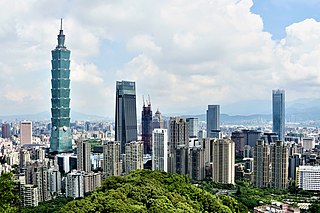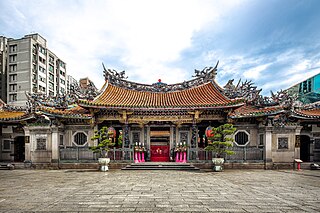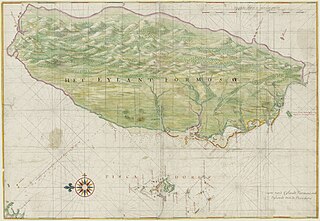
Taipei, officially Taipei City, is the capital and a special municipality of Taiwan. Located in Northern Taiwan, Taipei City is an enclave of the municipality of New Taipei City that sits about 25 km (16 mi) southwest of the northern port city of Keelung. Most of the city rests on the Taipei Basin, an ancient lakebed. The basin is bounded by the relatively narrow valleys of the Keelung and Xindian rivers, which join to form the Tamsui River along the city's western border.

Yangmingshan National Park is one of the nine national parks in Taiwan, located in both Taipei and New Taipei City. The districts that are partially in the park include Taipei's Beitou and Shilin Districts; and New Taipei's Wanli, Jinshan, Sanzhi and Tamsui Districts. The national park is known for its cherry blossoms, hot springs, sulfur deposits, fumaroles, venomous snakes, and hiking trails, including Taiwan's tallest dormant volcano, Qixing Mountain rising to 1,120 m (3,675 ft).

Wanhua District, known in Taiwanese Hokkien as Báng-kah khu and historically as "Monga" or "Monka", is a district in Taipei, Taiwan. It is Taipei's oldest district. The district is home to historic buildings such as the Bangka Lungshan Temple, an iconic historic temple, and the Red House Theater, the first and largest teahouse and playhouse in Taiwan. Taipei's oldest, but decaying, garment district is also here.

Beitou District is the northernmost of the twelve districts of Taipei City, Taiwan. The historical spelling of the district is Peitou. The name originates from the Ketagalan word Kipatauw, meaning witch. Beitou is the most mountainous and highest of Taipei's districts, encompassing a meadow with rivers running through the valley which have abundant steam rising from them; the result of geothermal warming. The valley is often surrounded by mist shrouding the trees and grass. Beitou is famous for its hot springs. In March 2012, it was named one of the Top 10 Small Tourist Towns by the Tourism Bureau of Taiwan.

Bangka Lungshan Temple is a Chinese folk religious temple in Wanhua District, Taipei, Taiwan. The temple was built in Taipei in 1738 by settlers from Fujian during Qing rule in honor of Guanyin. It served as a place of worship and a gathering place for the Chinese settlers. In addition to its Buddhist elements, it includes halls and altars to Chinese deities such as Mazu and Guan Yu.

Taiwan Railways Administration (TRA) was a governmental agency in Taiwan which operated Taiwan Railway from 1948 to 2023. It managed, maintained, and operated conventional passenger and freight railway services on 1,097 km (682 mi) of track. Passenger traffic in 2018 was 231,267,955.

Dadaocheng is an area in Datong District, Taipei, Taiwan. It was also known as Twatutia, Daitōtei during Japanese rule, and Tataocheng (Mandarin) during the Kuomintang era.

Wanli District, known in Basay as Masu, is a rural district on the rocky seacoast in northeastern New Taipei City in northern Taiwan. Wanli is a popular tourist destination and the site of the Cape Yeliu Miocene Formation which features distinctive hoodoo outcrops. The "Queen's Head" outcrop is a Taiwanese icon and serves as an informal trademark for the township. Kataw in the adjacent Jinshan District features the Wanli Taiwanese hot springs area, which is connected with the Jinshan Hot Springs (金山溫泉).

The National Taiwan Museum, established in 1908, is the oldest museum in Taiwan. It was founded by the colonial government during Taiwan's period of Japanese rule. The museum is located in Zhongzheng District, Taipei.

Zhongshan Hall is a historic building which originally functioned as the Taipei (Taihoku) City Public Auditorium. It is located at 98 Yanping South Road in the Ximending neighborhood of Zhongzheng District, Taipei, Taiwan. In 1992, it was recognized by the government as a historic site.

The recorded history of Taipei began with the Han Chinese settling of the Taipei Basin in 1709, leading up to the formation of the national capital of Taiwan and high-tech industry hub and that is now Taipei City. Other notable dates include the 1895 annexation of Taiwan by Japan, during which Taipei began to grow more rapidly, and in the 1950s, the USA's provision of financial assistance to the Republic of China government, after which the city continued on a path of fast structural and industrial growth.
Articles related to Taiwan include:

The 228 Peace Memorial Park is a historic site and municipal park located at 3 Ketagalan Boulevard, Zhongzheng District, Taipei, Taiwan. The park contains memorials to victims of the February 28 Incident of 1947, including the 228 Memorial Monument that stands at the center of the park and the Taipei 228 Memorial Museum, housed at the site of a former radio station that operated under Japanese and Kuomintang rule. The National Taiwan Museum stands at the park's north entrance. The park also has a bandshell and exercise areas.

The Taipei City Government is the municipal government of Taipei.

The Embassy of the United States, Taipei is a former United States diplomatic mission in Zhongshan District, Taipei, Taiwan. The building currently houses the Taipei Film House as a movie theater.

The 2010 Taipei International Flora Exposition opened on 6 November 2010 and ran until 25 April 2011 in Taipei, Taiwan. It was a garden festival recognized by the International Association of Horticultural Producers and was categorized as an A2/B1 horticulture exposition. It was the first such internationally recognized exposition to take place in Taiwan, and the seventh of its kind to take place in Asia. It is located near Yuanshan Station. The area is now converted to Taipei Expo Park.

The Beitou Hot Spring Museum is a museum about hot spring in Beitou Park, Beitou District, Taipei, Taiwan.

The Colonial Exhibition, Dutch: Koloniale Tentoonstelling, took place in Semarang, Dutch East Indies in from 20 August through 22 November 1914. Colonial exhibitions were trade expositions. It was designed to "give a comprehensive picture of the Dutch Indies in their present prosperous condition." It was the first large scale exposition in the Dutch East Indies, and financed by the participating corporations with a subsidy from the Dutch East Indies government.





















